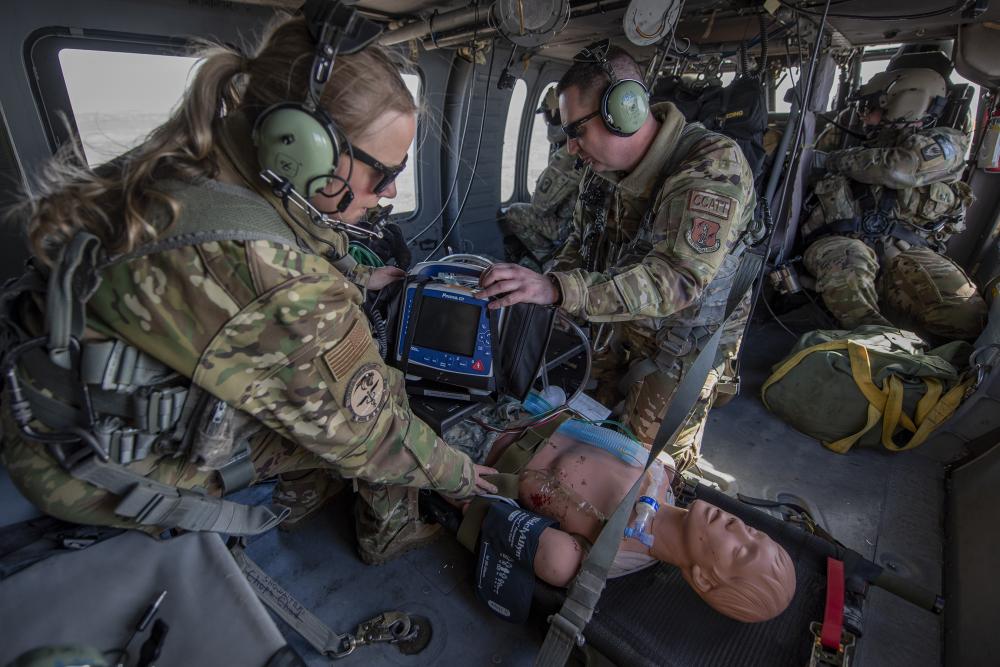One team, one fight: Army and Air join forces for mass casualty, medevac training

Idaho National Guard Soldiers and Airmen, as well as active duty counterparts joined forces with a one-team, one-fight mentality for joint training during a mass casualty exercise on Feb. 4 near Gowen Field.
“The best way to grow our mindset of becoming more operational and ready for a deployed environment is to train with the nearby resources, such as the Idaho Army National Guard and our active duty counterparts,” said Senior Master Sgt. Virginia Holmgren, a respiratory therapist from the Idaho Air National Guard’s 124th Medical Group. “Forming relationships with the other branches helps us to become familiar with each other’s capabilities and to practice working together because when we are in a deployed environment we will be working with the other branches in the fight.”
Medical personnel from Gowen Field’s 124th Medical Group and active duty medical personnel with the 366th Medical Group from Mountain Home Air Force Base teamed up for several mass casualty events, which also included the use of medevac Soldiers and UH-60 Black Hawk helicopters from the Idaho Army National Guard’s 1st of the 168th Aviation Regiment to participate in the medical evacuation scenarios.
“This exercise is a great example of how the Idaho National Guard is committed to the joint warfighting doctrine in support of the National Defense Strategy,” said Brig. Gen. Tim Donnellan, Idaho Air National Guard commander. “The 124th Medical Group coordinated this incredible training using combat proven units from the Idaho Army National Guard, the Idaho Air National Guard, and the Gunfighters of the 366th Fighter Wing.”
During the scenarios, combat medics performed treatment and stabilized casualties at a field medical tent in a simulated deployed location. The focus for the combat medics during the mass casualty scenarios was an emphasis on Tactical Combat Casualty Care. The TCCC is the military guideline for trauma life support in pre-hospital combat medicine, designed to reduce preventable deaths while continuing to maintain operation success.
“With our new DoD guidelines for the TCCC, it requires us to have more hands-on deck and for more Airmen to be familiar with trauma care in responding to worse injuries out on the field rather than the typical self aid and buddy care that we have focused on in the past,” said Senior Master Sgt. Davis Nguyen, the 124th Medical Group Function Area Manager.
Once medics respond and stabilize casualties, they could then recognize the patients that needed more advanced critical care at a hospital outside of the combat field location and the 9-Line medevac call requesting the Black Hawk medevac team was made. In combat, the 9-Line is an emergency medevac request with an accurate report of combat injuries that is often the difference between life and death.
The ground combat medics and the Black Hawk flight medics worked together to stabilize the casualty during flight until they reached the simulated higher echelon of medical care.
Additional scenarios required protective gear to be worn during a chemical, biological, radiological or nuclear event while Idaho National Guard Soldiers conducted hoist rescue training, allowing Airmen the chance to gain insight into a full range of rescue capabilities of the medevac Soldiers.
“I am proud of the commitment of the men and women in this joint, total force exercise demonstrating the incredible talent and the first class training capabilities we have here in Idaho,” said Donnellan. “We will continue to maintain our readiness for the immediate fight while preparing for any conflicts of the future.”
 Official Government Website
Official Government Website